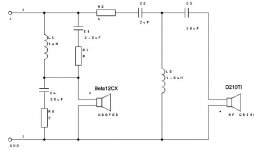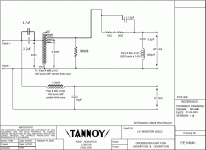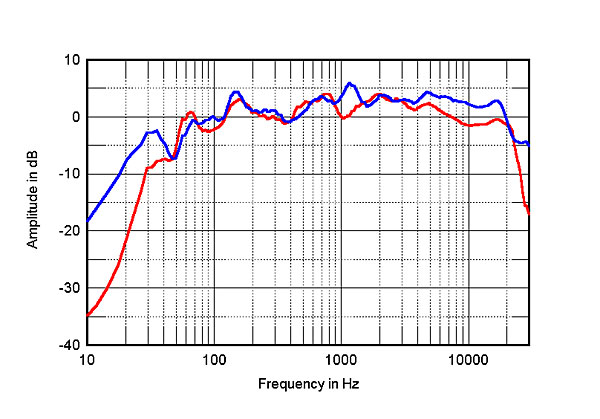Kef, with their last revision of Q and R series, made diy of bass asisted coaxial or small coaxial two way pointless. For that amount of money you get what is in my oppinion easily the best coaxial available. Cabinets are made of mdf and you can choose a finish that suits you. There is some work needed on crossover but that's the case with diy also.
Look at that measurements of Q350. With only 3 components it measures that good. Imagine what it would do with properly designed crossover. Frank Landmesser modified LS50 and made it great just by revisioning the midwoofer crossover. So, other than some extraordinary looks of finished loudspeaker i can't think of a reason not to buy Kef uni-q speaker and modify it. Zaph measured a 5" from Q100 series. You might want to compare it with some Seas and ScanSpeak expensive drivers. New Q series, as Atkinson says, incorporates cones and motors from R series that has even lower distortion.
Look at that measurements of Q350. With only 3 components it measures that good. Imagine what it would do with properly designed crossover. Frank Landmesser modified LS50 and made it great just by revisioning the midwoofer crossover. So, other than some extraordinary looks of finished loudspeaker i can't think of a reason not to buy Kef uni-q speaker and modify it. Zaph measured a 5" from Q100 series. You might want to compare it with some Seas and ScanSpeak expensive drivers. New Q series, as Atkinson says, incorporates cones and motors from R series that has even lower distortion.
Last edited:
As long as the KEFs are not voiced to appeal to the "punter" buyer .Which is the problem with so many mid- priced speakers.They tend to have that emphasised boxy sort of bass with a lot of loose low bass coming out of a port and an emphatic treble.The classic doof doof /tizz tizz presentation.
I'm a bit worried about the reports that the KEFs need to be listened at higher volumes, as I find listening with 85 dB peaks as loud as I want my music. I wonder if that characteristic comes from the drivers or the "tuning ". The Q350 seems to have a lot of midbass.
If you are going to build something, you decide on voicing with crossover that you design. If i'd buy Kef loudspeakers i know that their crossover wouldn't remain inside so their crossover or how it's voiced is of no interest to me.
I'm trying to say that their drivers and cabinets are of good quality. I've had the chance to open them and measure them. They need new crossover and maybe some struts in the cabinets but that's it.
I'm trying to say that their drivers and cabinets are of good quality. I've had the chance to open them and measure them. They need new crossover and maybe some struts in the cabinets but that's it.
I always wanted to try coax, good luck!
Here's some info I collected a while ago (through ol' Thorsten):


http://www.diyaudio.com/forums/multi-way/54075-seas-t17-t18-coaxial-loudspeakers.html#post603920
PAudio 15" coax success! ....pic............. - [email]waveboxes@yahoo.com[/email] - High Efficiency Speaker Asylum
High Efficiency Speaker Asylum: An example of HOW GOOD speakers where nearly 70 Years ago.... by Thorsten
saxFB
View attachment Seas H1144 Box and Xover.pdf
View attachment T18RE t speak.pdf
Cheers,
Jeff
Here's some info I collected a while ago (through ol' Thorsten):


http://www.diyaudio.com/forums/multi-way/54075-seas-t17-t18-coaxial-loudspeakers.html#post603920
PAudio 15" coax success! ....pic............. - [email]waveboxes@yahoo.com[/email] - High Efficiency Speaker Asylum
High Efficiency Speaker Asylum: An example of HOW GOOD speakers where nearly 70 Years ago.... by Thorsten
saxFB
View attachment Seas H1144 Box and Xover.pdf
View attachment T18RE t speak.pdf
Cheers,
Jeff
The "listened to at higher volumes" is likely a function of the driver's mechanical resistance (surround, not spider) - in effect they need to have a bit of excursion to get past added resistance from the driver's surround - which it doesn't do well at low pressures.I'm a bit worried about the reports that the KEFs need to be listened at higher volumes, as I find listening with 85 dB peaks as loud as I want my music. I wonder if that characteristic comes from the drivers or the "tuning ". The Q350 seems to have a lot of midbass.
A rise in response in the midbass is usually an a near-field measurement artifact - where at 2 meters you wouldn't see that sort of rise. (Stereophile..)
Ironically, you'll typically see more midbass (relative to the average) as the loudspeaker's *price* is **increased**. (..though on the Soundstage Network measurements you'll note that they are all *2* meter measurements plotted at 1 meter - so they don't show the exagerated ("rise") baffle-step compensation that a 1 meter measurement shows (..like Stereophiles).)
KEF specifically voices their less expensive models "hot" in the upper midrange and lower treble. This results in a "bright" and "forward" character - more so with the increased directivity of the waveguide-load tweeter. (..the freq. range in particular is usually an octave above and below 1.5 kHz - so around 750Hz to 3kHz).
As Zvu mentions - really good driver design (..and their boxes aren't bad - with very good fit and finish), but their cheaper stuff is in need of a different crossover to lower the pressure in that region around 1.5 khz. This will however put more strain/compression on the midbass relative to the average if it's just a 2-way 2-driver design. They do however have nice less expensive multi-driver designs that can be altered and that won't suffer nearly as much compression as a result.
Stereophile's Atkinson talks with Jack Oclee-Brown of KEF. They have voiced the new Qx50 series and the Wireless LS50 differently from previous models, which suffered from too much "clarity" and lean bass (seen in in-room measurements and verified by my listening experience).
YouTube
Here's the older - Q100, quite bad if i may say so. From listening, i think that newer (Q150) measures much better.
An externally hosted image should be here but it was not working when we last tested it.
And being in 8 liters, with TS i've measured and box tuned at 55Hz there's hardly any base.
Last edited:
One more - just to see where the problems come from.
That's what 3 component crossover does to the drivers.
That's what 3 component crossover does to the drivers.
An externally hosted image should be here but it was not working when we last tested it.
Last edited:
^No bsc at all, high br tuning, low xmax... I have never understood the hype of LS50, and the funniest thing is that it sits always far from wall, on a pole!
Red line, in-room response at Atkinson's room

Red line, in-room response at Atkinson's room

LS50 is made to be listened nearfield - but people doesn't seem to get that and that is the main reason for their abuse. They try to listen to them in farfield but they need crossover revision for that.
..nearfield AND off-axis (probably around 20 degrees).
KEF LS50 Anniversary Model loudspeaker Measurements | Stereophile.com
Note that figure 3 is *averaged* over a 30 degree window that's referenced to 0 degrees (ie. +/- 15 degrees).
-better to look at figure 4 (several "steps" from 0 degrees).
KEF LS50 Anniversary Model loudspeaker Measurements | Stereophile.com
Note that figure 3 is *averaged* over a 30 degree window that's referenced to 0 degrees (ie. +/- 15 degrees).
-better to look at figure 4 (several "steps" from 0 degrees).
Kef LS50
Part of the problems could come from driver tolerances. Two samples:
An externally hosted image should be here but it was not working when we last tested it.
Part of the problems could come from driver tolerances. Two samples:
An externally hosted image should be here but it was not working when we last tested it.
..nearfield AND off-axis (probably around 20 degrees).
KEF LS50 Anniversary Model loudspeaker Measurements | Stereophile.com
Note that figure 3 is *averaged* over a 30 degree window that's referenced to 0 degrees (ie. +/- 15 degrees).
-better to look at figure 4 (several "steps" from 0 degrees).
That is the thing i really don't understand. People going through trouble to make loudspeakers with waveguides that measures good and then they don't toe them in. What's the point of a waveguide if you don't toe in the mofos ?
That's one of the reasons why with waveguide loaded loudspeakers frequency response needs to be flat on axis - because you'll be listening to these off axis. Of course the sound will be too bright on axis - especially in the nearfield.
@Kimmo: That looks like the cone on the one of them is a little in/out ?
Last edited:
@Kimmo: That looks like the cone on the one of them is a little in/out ?
I did not see any difference or problem in installation. Funny thing is that worse sample is original and better one is with new replacement driver due to damage of original.
---
Here is my Q100, less than two years old. Agree that high frequencies are damaged due to too simple crossover. Sound is also a bit boxy due to thin and light side walls, but otherwise it is quite balanced. This kind of coax constructions have high IM distortion which makes sound fuzzy. Have to be 3- or 4-way to get clean sound. The same issue with Seas coaxs.
To Juhazi: BSC is actually okay.
An externally hosted image should be here but it was not working when we last tested it.
Last edited:
.... BSC is actually okay...
My measurement is done from 1m distance with 2dB grid so that may confuse people because it's a bit rare.
There is that 800Hz 2dB hump in midwoofer response that should be dealt with. That 1200Hz dip-peak combo is a product of bass reflex opening.
If the BSC of LS50 is ok, how can Atkinson's in-room measurement be so lean on bass and even midrange? We must compare it to his other measurements. The inter-relation of his combined near-farfield vs. in-room.
LS50 mimics sonically the original LS3/5A, which was meant to be a lightweight nearfield monitor to be used in BBC's broadcast vans, basically to just monitor inteviews/speech! LS3/5A - Wikipedia
LS50 mimics sonically the original LS3/5A, which was meant to be a lightweight nearfield monitor to be used in BBC's broadcast vans, basically to just monitor inteviews/speech! LS3/5A - Wikipedia
Part of the problems could come from driver tolerances. Two samples:
An externally hosted image should be here but it was not working when we last tested it.
..That 1200Hz dip-peak combo is a product of bass reflex opening.
I think this is likely the surround resonance (anti-phase movement).
A "tighter"/stiffer surround tends to result in a more narrow exgerated depression, where a surround that's a bit more compliant tends to increase the depression in bandwidth (operating over a wider freq. range), typically resulting in slightly less pressure for the effect (freq. depresion) vs. the narrow/deeper result.
Usually too much averaging and the differences aren't as apparent. (..the "narrow/deeper" result tends to look better with averaging.)
Last edited:
- Home
- Loudspeakers
- Multi-Way
- Coaxial drivers for ultimate speaker?